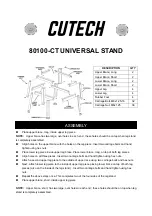
Chapter 2: Hardware Installation
components.
6. Because hard drives are prone to damage due to shock and
vibration during operation, all hard drives should be installed in a
rack cabinet prior to powering up.
7. Drives must not be stacked on top of each other without their
protective drive trays. Even when drives are fixed in the drive
trays, contact with the exposed PCB or interface pins may result
in ESD damage which will yield immediate or latent failures.
8. Stacking drives one upon another can result in erasing the IC
programmable contents.
9. When replacing components, insert them as gently as possible
while assuring full engagement. Vibration and shock can easily
damage hard drives during operation. Handle hard drives with
extreme care.
10. Place the power cords and all cables away from foot traffic. Do
not place anything over the power cords. After the enclosure is
installed into the rack, carefully route the power cords and data
cables so that power cords are not resting against data cables.
11. If the enclosure is not used for a long time, disconnect it from
mains to avoid transient over-voltage.
12. For safety reasons, only qualified service personnel can open the
enclosure chassis.
13. If any of the following situations occurs, contact service
personnel:
a.
The power cord or plug is damaged.
b.
The equipments have been exposed to moisture.
c.
The enclosure has not worked well or you cannot get it work
as the manual states.
d.
The enclosure has been dropped against a hard surface.
e.
The enclosure shows obvious signs of breakage.
14. Thermal notice: All drive trays (even if they do not contain hard
drives) must be installed into the enclosure. Leaving a drive bay
or module bay open will seriously affect the airflow efficiency,
and consequently lead to overheating. Keep a faulty module in
place until you have a replacement unit and are ready to replace
it.
15. An enclosure without disk drives can weigh more than 20
2-5
















































